Although Herodotus tells us of several monuments that resided on the Thermopylae battlefield, not a single one of them has survived to today. However, there are numerous modern recreations. One in particular pays tribute to the last stand of the Spartans and their Thespian allies on Kolonos Hill, the probable spot where they fell. ((The topography has changed dramatically in 2,500 years. We’ll cover that in a later post.))
To get to the monument, you must climb the stone steps of Kolonos, only 45 ft high.
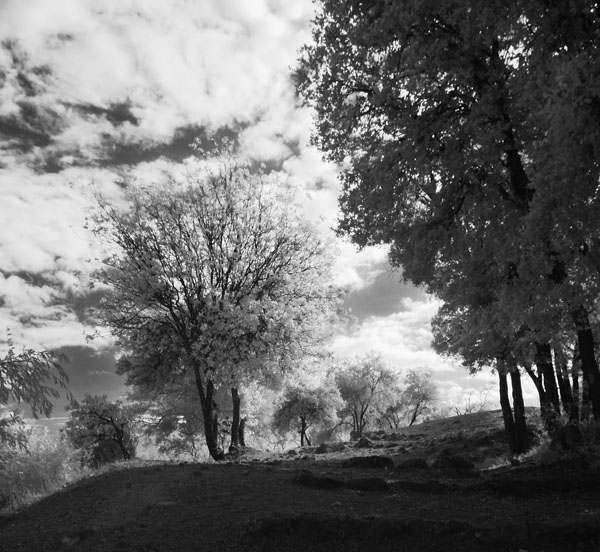
If you ever have the privilege of making the trek, be sure to pay tribute to the battle in your own personal way.
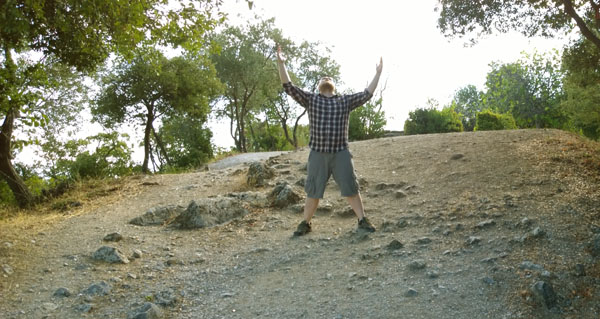
At the top, you will have a magnificent view. This photo faces west, the direction from which the Persians attacked the Spartan defenses at Thermopylae. The road that peaks out from behind the tree in the middle, right-hand side of the photo marks roughly where the sea would have touched in 480 BC.

In addition, you will see a stone slab bearing an ancient Greek inscription.
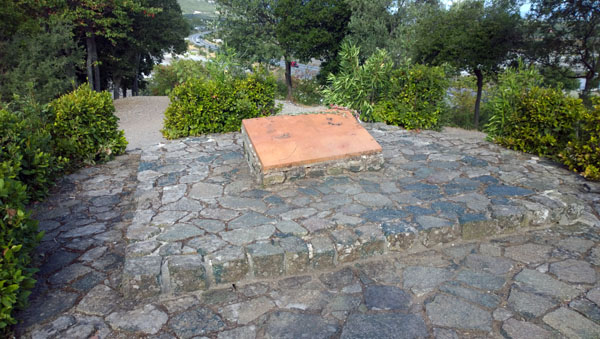
Steven Pressfield’s popular novelization of Thermopylae–Gates of Fire–erroneously identified this stone slab as an original ancient monument. However, this is a modern recreation, placed in 1955. ((Monica Silveira Cyrino, “‘This is Sparta!’: The Reinvention of the Epic in Zack Snyder’s 300,” in The Epic Film in World Culture, ed. Robert Burgoyne (New York: Routledge, 2011), 35n11.))
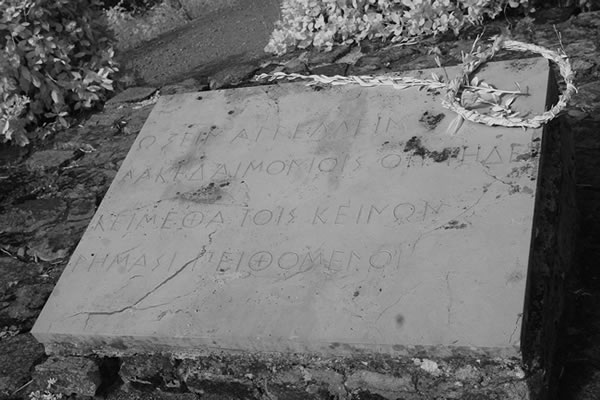
The Greek inscription translates roughly to:
Oh stranger, tell the Lacedaemonians that here we lie, obedient to their laws. ((Translation help from Aristotle, the best Greek tourist guide))
Greeks often referred to the Spartans as Lacedaemonians, as Sparta resided in the Lacedaemonia region. Obeying their laws meant fighting to the death as ordered.
The epitaph has made it down from over 2,500 years. Herodotus (c. 484-425 BC) said one of the original monuments he found at Thermopylae brandished the inscription (7.228). The source of the epitaph was poet-propagandist Simonides (c. 556-468). The Spartans would have paid him handsomely for his work. ((Paul Cartledge, After Thermopylae: The Oath of Plataea and the End of the Graeco-Persian Wars (Oxford: Oxford University Press, 2013), 139-144.))
Numerous poets and orators regurgitated or appropriated the quote. The most famous was Cicero (106-43 BC) who admired it along with the leadership of Leonidas. ((Cicero, Tusculanae Disputationes, translated by George Alexander Otis (Boston: Mes B. Dow, 1839), 75.)) By the time geographer Strabo (c. 63 BC – 24 AD) made it to Thermopylae 500 years after the battle, this was the only epitaph he recorded among the monuments (9.4.16). He referred to it as the “oft-quoted inscription,” meaning it was still popular 5 centuries later.
Enduring Influence
In the past century, the continued regurgitation and appropriation of Simonides’s epitaph attests to its lasting influence. However, the meaning does not always equate to a glorious or noble death. After his son died during World War I, poet Rudyard Kipling was inspired to write:
If any question why we died,
Tell them, because our fathers lied. ((Originally published as “Common Form” in Rudyard Kipling, The Years Between (New York: Doublday, 1919), 137.))
Perhaps the most infamous person to appropriate the epitaph was Hermann Göring. In the waning days of Stalingrad in 1942, he attempted to encourage his troops with thoughts of Leonidas at Thermopylae,
If you come to Germany, tell them you have seen us fighting in Stalingrad, obedient to the law of honor and warfare. ((Paul Cartledge, Thermopylae: The Battle that Changed the World (New York: Vintage Books, 2006), 192.))
The doomed German troops listening over radio in Stalingrad reportedly did not care much for Göring’s sentiment. ((Martin M. Winkler, Cinema and Classical Texts: Apollo’s New Light (Cambridge: Cambridge University Press, 2009), 186.))
Another modern appropriation comes from Australian poet A. D. Hope (d. 2000) whose 1971 poem “Inscription for War” came at the height of Vietnam. It strips the glory out of the epitaph entirely.
Linger not, stranger; shed no tear;
Go back to those who sent us here.
We are the young they drafted out
To wars their folly brought about.
Go tell those old men, safe in bed,
We took their orders and are dead. ((Available in Jay Parini, ed., The Wadsworth Anthology of Poetry (Boston: Thomson Wadsworth, 2006), 1139-1140.))
When Hope published his poem, he included Simonides’s words in an epigraph. ((Stuart Rees, Passion for Peace: Exercising Power Creatively (Sydney: UNSW Press, 2003), 97-98.))
In the Vietnam film Go Tell the Spartans (1978), an American unit makes a last stand in a French graveyard. Above the graveyard is an epitaph in French, which a corporal explains, “I think it refers to the battle of Thermopylae where 300 Spartans died trying to hold the pass, if you remember your Greek histories.”
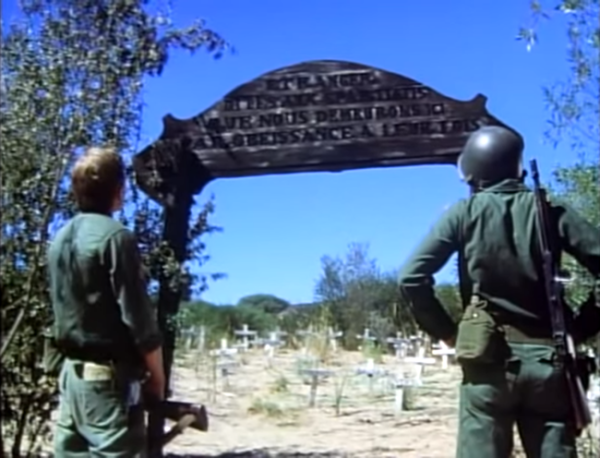
He translates it for a superior officer,
Stranger, when you find us lying here,
Go tell the Spartans we obeyed their orders
The movie ends horrifically for the Americans and one of the final shots is the torn down French epigraph.
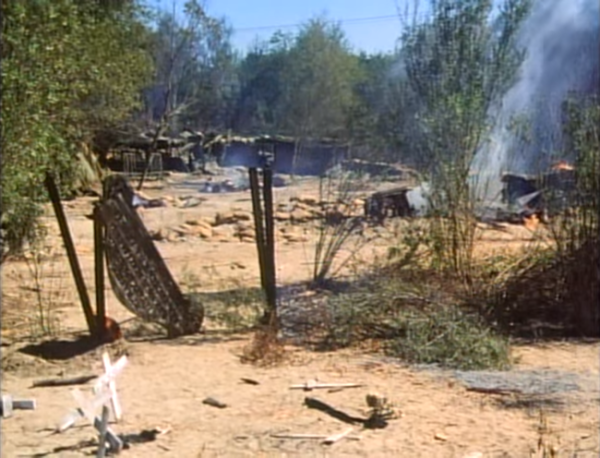
Today, the quote lives on in pop culture, as the 300 graphic novel and movie have given it new life, without the irony.
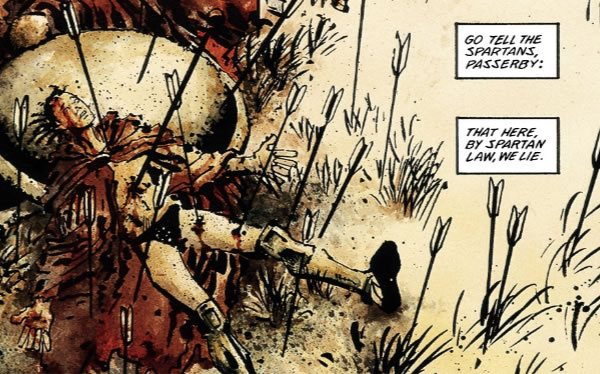
Steven Pressfield believes the “verses comprise perhaps the most famous of all warrior epitaphs.” Whatever the Spartans paid Simonides for his work, it was worth it.
